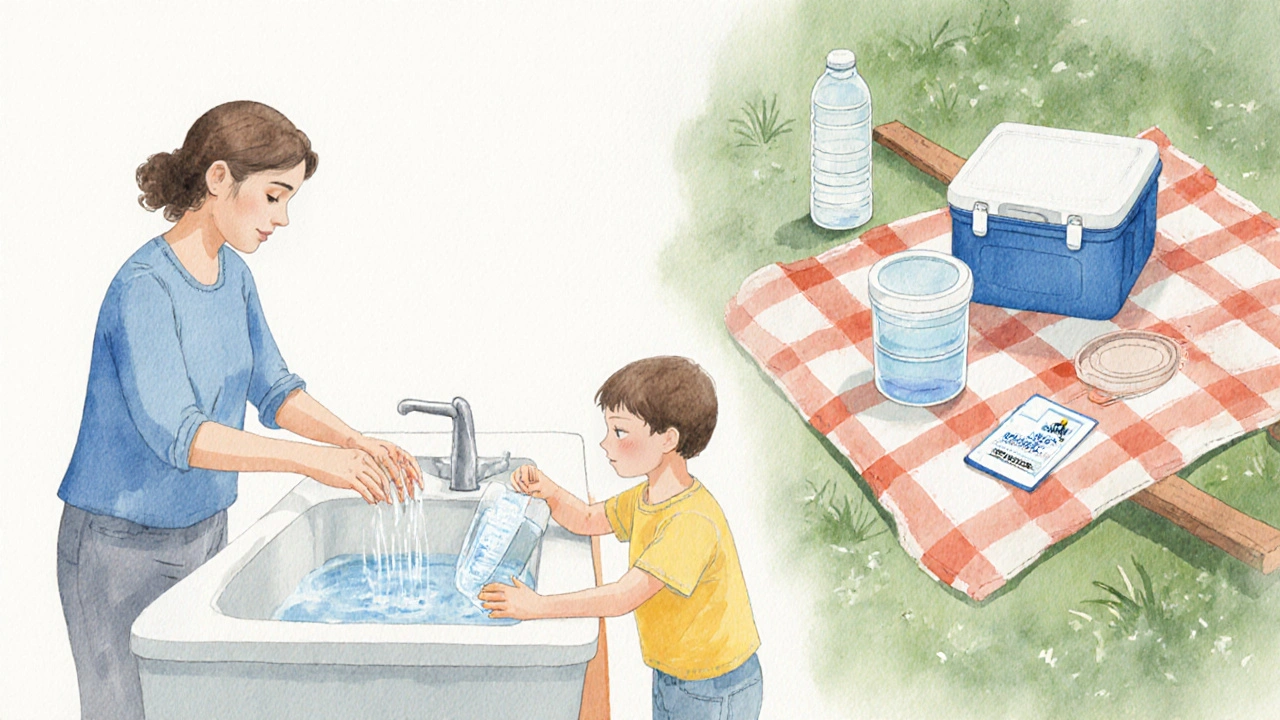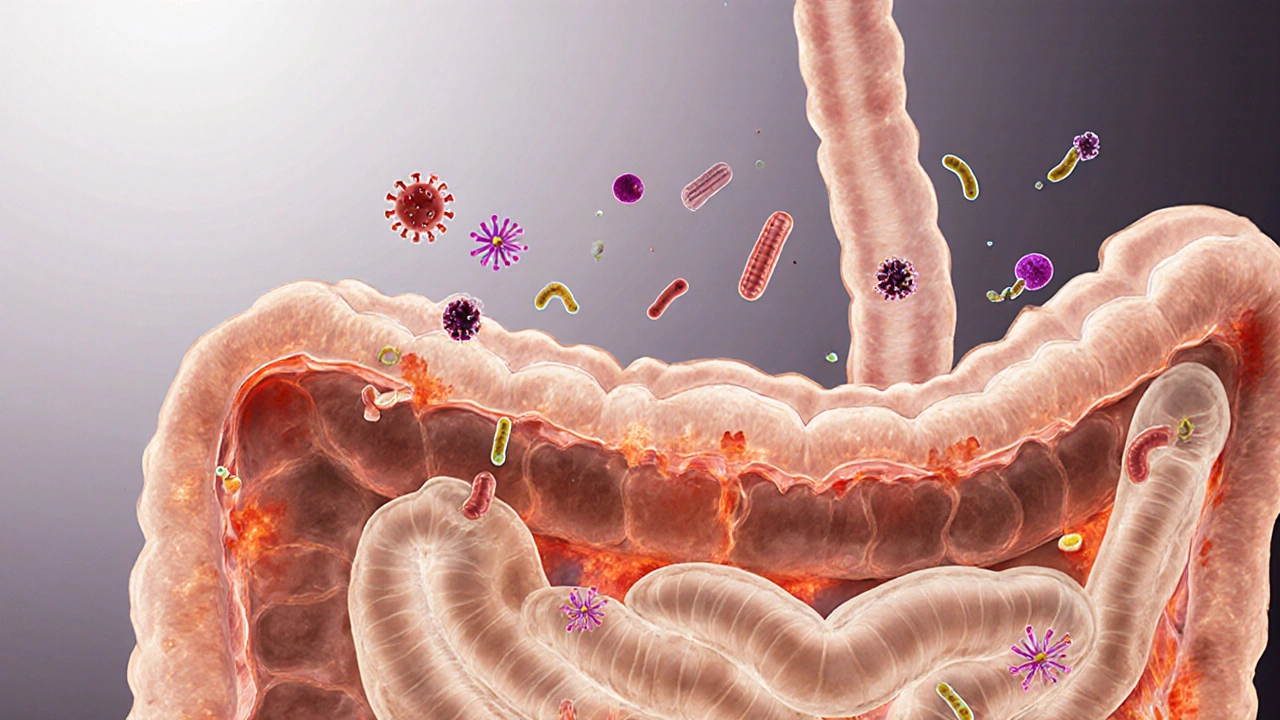Enteric Infection Prevention Assessment Tool
How well are you preventing enteric infections?
Answer these questions about your food handling and hygiene practices. This assessment will help you identify areas where you can improve to reduce your risk of gut infections.
Your Prevention Score
Based on your answers, you're following 0 out of 7 key prevention steps.
Recommended improvements:
When it comes to gut health, Enteric infection is a type of gastrointestinal infection caused by pathogens that invade the intestinal tract, leading to diarrhea, abdominal pain, and sometimes fever. Understanding which germs cause these illnesses and how to keep them at bay can spare you weeks of discomfort and costly doctor visits.
Key Takeaways
- Six bacteria, two viruses, and two protozoa account for the majority of enteric infections in the UK.
- Contamination usually comes from raw meat, unpasteurised dairy, contaminated water or person‑to‑person spread.
- Simple steps - proper cooking, hand washing, safe water, and food storage - block more than 80% of cases.
- High‑risk groups (young children, elderly, immunocompromised) should be extra vigilant.
- Seek medical help if symptoms persist beyond three days, blood appears in stool, or you develop a high fever.
What Exactly Is an Enteric Infection?
Enteric infections target the lining of the small and large intestines. The offending organisms can be bacteria, viruses or protozoa. Once inside, they multiply, release toxins or trigger inflammation, which disrupts fluid absorption and causes the classic symptoms of watery or bloody stools, cramps, nausea and sometimes vomiting.
Most Common Bacterial Culprits
These six bacteria are responsible for the bulk of reported cases in England and Wales.
- Salmonella is a gram‑negative bacterium often found in raw poultry, eggs and pet reptiles. It produces fever, abdominal cramps and diarrhea that can last a week.
- Shigella spreads easily in crowded settings through the fecal‑oral route. It causes high‑fever, bloody stools and can trigger reactive arthritis.
- Campylobacter thrives in undercooked chicken and unpasteurised milk. Symptoms appear 2‑5 days after exposure and include severe cramps and sometimes Guillain‑Barré syndrome.
- Escherichia coli (particularly the O157:H7 strain) contaminates beef, fresh produce and water. It can cause bloody diarrhoea and, in rare cases, kidney failure.
- Listeria monocytogenes is linked to ready‑to‑eat meats, soft cheeses and deli salads. Although less common, it is dangerous for pregnant women and the elderly.
- Clostridioides difficile often follows antibiotic use, leading to colitis with profuse watery stools and toxic megacolon in severe cases.

Frequent Viral Triggers
Two viruses dominate seasonal outbreaks.
- Norovirus spreads through contaminated food, water, surfaces and close contact. It is notorious for cruise‑ship and care‑home outbreaks, causing vomiting and watery diarrhoea that resolve in 1‑3 days.
- Rotavirus primarily affects infants and toddlers, especially those not fully vaccinated. It leads to severe watery diarrhoea and dehydration.
Protozoan Parasites You Should Know
These two protozoa are common in untreated water and fresh produce.
- Cryptosporidium forms oocysts that survive chlorine. Infection results in prolonged watery diarrhoea, particularly in people with weakened immunity.
- Giardia duodenalis (also called Giardia lamblia) causes greasy stools, bloating and weight loss. It is common after hiking or drinking from unfiltered streams.
How These Pathogens Reach Your Gut
Understanding the transmission routes helps you block them.
- Improper cooking - undercooked poultry or ground beef may retain live bacteria.
- Cross‑contamination - using the same cutting board for raw meat and fresh vegetables spreads germs.
- Contaminated water - untreated tap water, ice cubes or unpasteurised juices can harbour protozoa and viruses.
- Person‑to‑person - hands that haven’t been washed after using the toilet can transmit Shigella or Norovirus.
- Food handling errors - leaving perishable foods at room temperature beyond two hours encourages bacterial growth.

Practical Prevention Checklist
These actions cut the risk dramatically.
- Cook poultry to an internal temperature of 75°C (165°F) and ground meat to 71°C (160°F).
- Wash hands with soap for at least 20 seconds before handling food, after bathroom use, and after touching animals.
- Use separate cutting boards: one for raw meat, another for fruits and vegetables.
- Store leftovers in shallow containers within two hours and refrigerate at 4°C (40°F) or below.
- Drink only treated or bottled water when traveling abroad; filter water when outdoor camping.
- Ensure infants receive the rotavirus vaccine; consider booster doses for elderly in care homes.
- Avoid raw or unpasteurised dairy products, especially soft cheeses.
Quick Reference Table
| Pathogen | Type | Typical Sources | Main Symptoms | Key Prevention |
|---|---|---|---|---|
| Salmonella | Bacterium | Raw poultry, eggs, reptile contact | Fever, abdominal cramps, watery or bloody diarrhoea | Cook to 75°C, avoid cross‑contamination |
| Shigella | Bacterium | Contaminated hands, salads, water | High fever, bloody stool, tenesmus | Hand hygiene, wash produce thoroughly |
| Campylobacter | Bacterium | Undercooked chicken, raw milk | Severe cramps, diarrhoea, possible Guillain‑Barré | Cook chicken fully, pasteurise milk |
| Escherichia coli O157:H7 | Bacterium | Undercooked beef, fresh produce | Bloody diarrhoea, hemolytic‑uremic syndrome | Cook beef to 71°C, wash veggies |
| Norovirus | Virus | Contaminated food, surfaces, close contact | Vomiting, watery diarrhoea, rapid onset | Disinfect surfaces, wash hands, avoid sharing utensils |
| Rotavirus | Virus | Fecal‑oral spread among children | Severe watery diarrhoea, dehydration | Vaccination, rigorous hand washing |
| Cryptosporidium | Protozoa | Untreated water, swimming pools | Prolonged watery diarrhoea, especially in immunocompromised | Filter/boil water, avoid swallowing pool water |
| Giardia duodenalis | Protozoa | Unfiltered surface water, contaminated food | Greasy stools, bloating, weight loss | Use certified filters, practice hand hygiene |
When to Seek Professional Care
If you notice any of the following, book a GP appointment promptly:
- Diarrhoea lasting more than three days
- Blood or mucus in stool
- Fever above 38.5°C (101.3°F) accompanying gut symptoms
- Signs of dehydration: dry mouth, dizziness, reduced urine output
- Severe abdominal pain or vomiting that prevents keeping fluids down
High‑risk groups-children under five, pregnant women, the elderly and anyone on immunosuppressive medication-should contact a health professional even with milder symptoms.
Frequently Asked Questions
What is the difference between bacterial and viral enteric infections?
Bacterial infections are caused by living microorganisms that can multiply in the gut and often produce toxins (e.g., Salmonella, E. coli). Viral infections involve non‑cellular agents that hijack host cells to replicate (e.g., Norovirus, Rotavirus). Bacterial cases may need antibiotics, whereas viral infections resolve on their own and are managed with rehydration.
Can I get an enteric infection from restaurant food?
Yes. Improperly cooked chicken, under‑cooked eggs, or cross‑contaminated salads are common sources. Choosing reputable eateries that follow food‑safety standards, and avoiding raw or undercooked items, reduces the risk.
Does washing fruit with water remove all pathogens?
Rinsing helps, but it may not eradicate parasites like Cryptosporidium or bacteria hidden in crevices. Using a vinegar‑water solution (1 part vinegar to 3 parts water) or a commercial produce wash gives extra protection.
How long can Norovirus survive on surfaces?
Norovirus can remain infectious for days on hard surfaces like countertops and door handles. A bleach solution (1000ppm) or alcohol‑based disinfectant applied for at least 30seconds effectively inactivates it.
Is it safe to drink tap water while traveling abroad?
Only if the destination’s public water system meets WHO standards. In many developing regions, it’s wiser to use bottled water, boil tap water for at least one minute, or employ a certified portable filter before drinking.

15 Comments
Arianne Gatchalian
Thanks for pulling together such a thorough rundown. The checklist format makes it easy to spot what I’m missing in my kitchen routine. I’ve started cooking chicken a bit longer after reading the temperature tip, and the difference is already noticeable. Keeping leftovers in shallow containers is a habit I’ll adopt from now on. Keep the great content coming!
Aly Neumeister
I never realized how many steps I skip daily!
joni darmawan
Reading through the pathogen list was eye‑opening. The way the article ties each bug to a concrete food source helps cement the preventive steps. I appreciate the balance of scientific detail and practical advice – not too dense, not too fluffy. The emphasis on vulnerable groups aligns with public‑health priorities. Overall, a solid resource for anyone wanting to safeguard their gut.
Richard Gerhart
Yo, the part about using separate cutting boards is a game‑changer. I used to toss everything on one board and never thought about cross‑contam. Also, cooking ground meat to 71°C? I’ll set my meat thermometer to that exact number now. Thanks for making it so straight‑forward. Good stuff!
Kim M
Wow, this is exactly why I always carry a water filter when I travel 😂
Martin Gilmore
First off, the grammar in the tables is immaculate; kudos! Second, the over‑use of commas in the checklist is a bit much-consider trimming. Third, the pathogen names should be italicized for clarity-just a thought. Fourth, the risk‑level colors (green, yellow, red) are spot‑on for quick visual cues. Fifth, you might want to add a note about refrigeration temps in Fahrenheit for US readers. Sixth, the tip about boiling water for travelers could mention a 1‑minute boil time. Seventh, the FAQ section is thorough, but a “quick‑look” summary at the top would help. Eighth, overall, excellent work-keep it up!
jana caylor
Loved the way you broke down each pathogen’s usual source-makes it easy to remember. The bullet‑point checklist feels like a cheat sheet I can print and hang in the kitchen. I’m especially glad you highlighted the rotavirus vaccine for infants; many parents overlook that. Thanks for the practical tips, and looking forward to more health‑focused guides!
Vijendra Malhotra
Namaste! This post beautifully bridges the gap between scientific jargon and everyday kitchen habits. In India we often rely on traditional cooking methods, but the temperature guidelines are universal. I’d add a note about using a food‑grade thermometer-many local markets sell cheap ones that work fine. Also, a reminder to wash fresh produce with a mild vinegar solution can curb protozoa. Fantastic job, keep spreading the knowledge!
Nilesh Barandwal
Clear, concise, and dramatic-exactly what the internet needs! The risk‑level colors pop. A quick glance tells you everything.
Elise Smit
This guide is a great blend of science and practicality. The step‑by‑step checklist is something I can hand to my teenage kids. Emphasizing hand‑washing duration (20 seconds) is a subtle yet powerful reminder. I also like the note on proper storage-shallow containers make cooling faster. Thank you for making gut‑health awareness accessible!
mathokozo mbuzi
The formal tone and thorough referencing give this article credibility. Including both bacterial and viral agents ensures a comprehensive overview. The recommendation to seek medical attention after three days of symptoms is prudent. I would suggest adding a brief note on antibiotic stewardship for bacterial infections. Overall, a commendable contribution to public health education.
Penny X
In the realm of public health literature, this exposition stands as a paragon of meticulousness. The author has judiciously enumerated each pathogen, elucidating its epidemiology with pristine precision. One observes a commendable adherence to scholarly decorum, eschewing colloquialities for erudite diction. The preventive checklist is delineated with an elegance befitting of its gravitas. Such a manuscript merits dissemination across academic and lay audiences alike.
Amy Aims
Super useful guide! 😊 The emojis really brightened up the read. I’ll definitely share this with my friends who love camping. Keep the tips coming!
Miriam Bresticker
Ths is awsome info, thx 4 sharing 🙃 I love the part about water filterz. Gonna try the vinegar wash hack soon.
Claire Willett
Comprehensive risk matrix; aligns with HACCP terminology. For clinicians, the pathogen‑specific symptomatology aids differential diagnosis. Recommend adding a QR code for the checklist download. Overall solid deliverable.